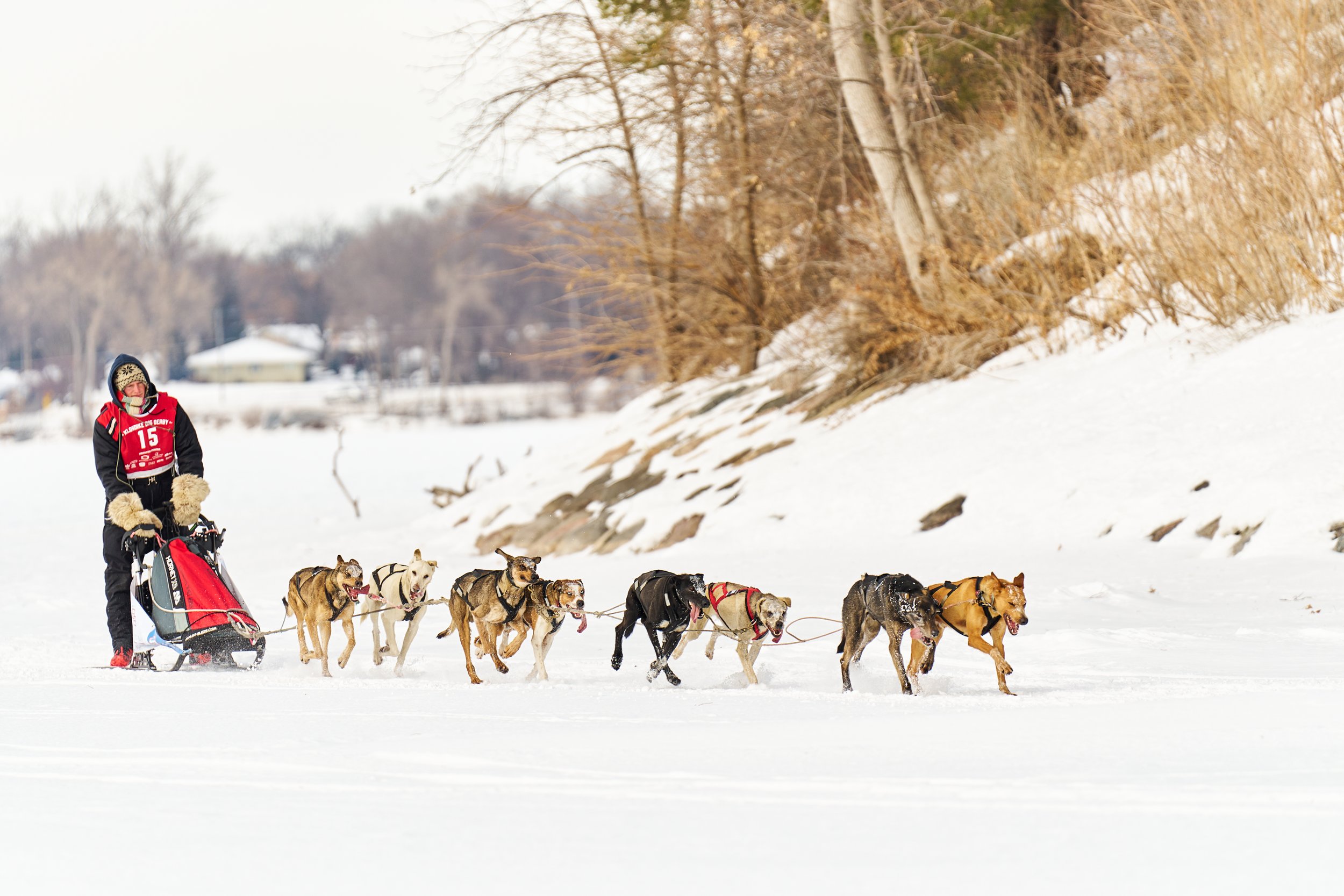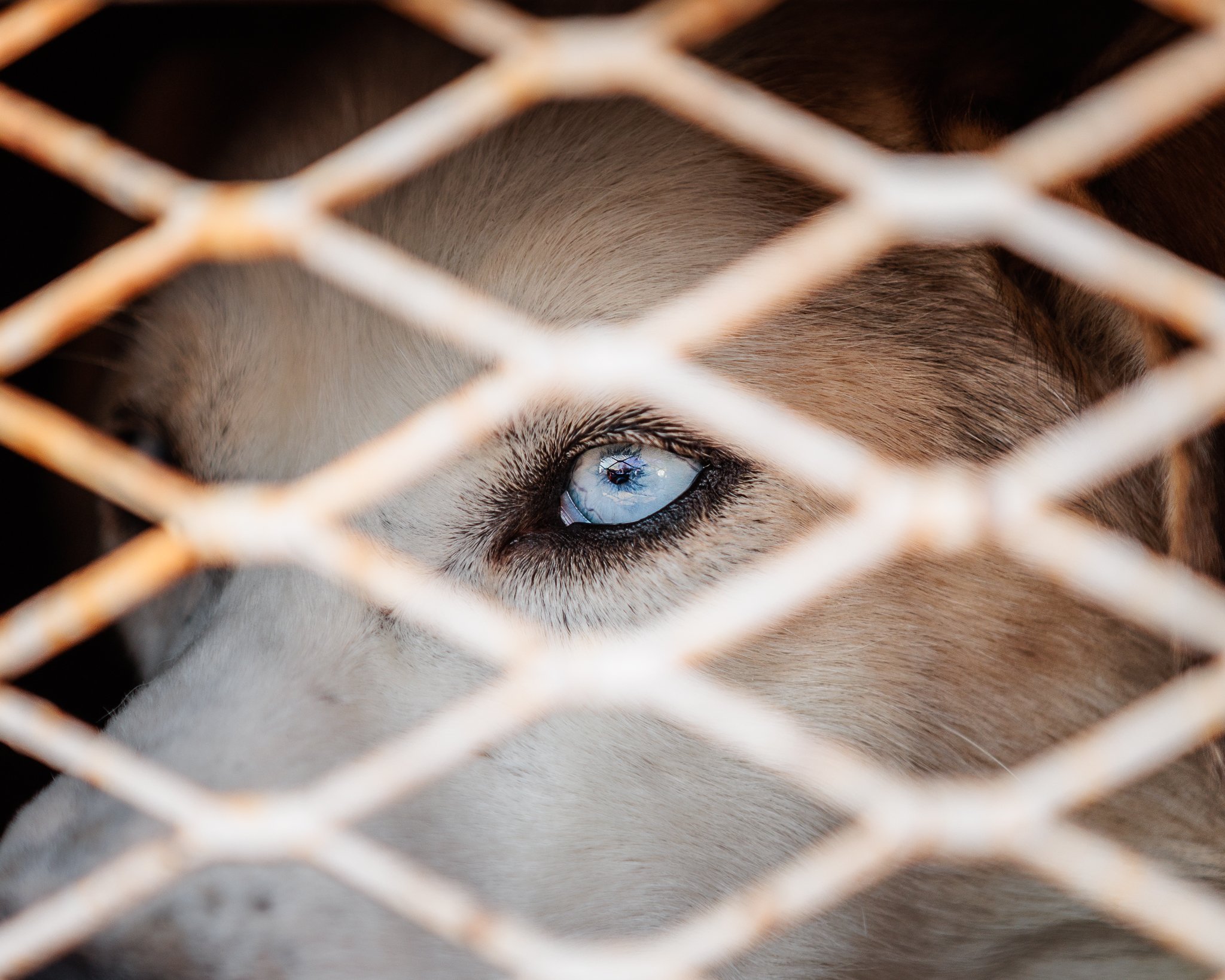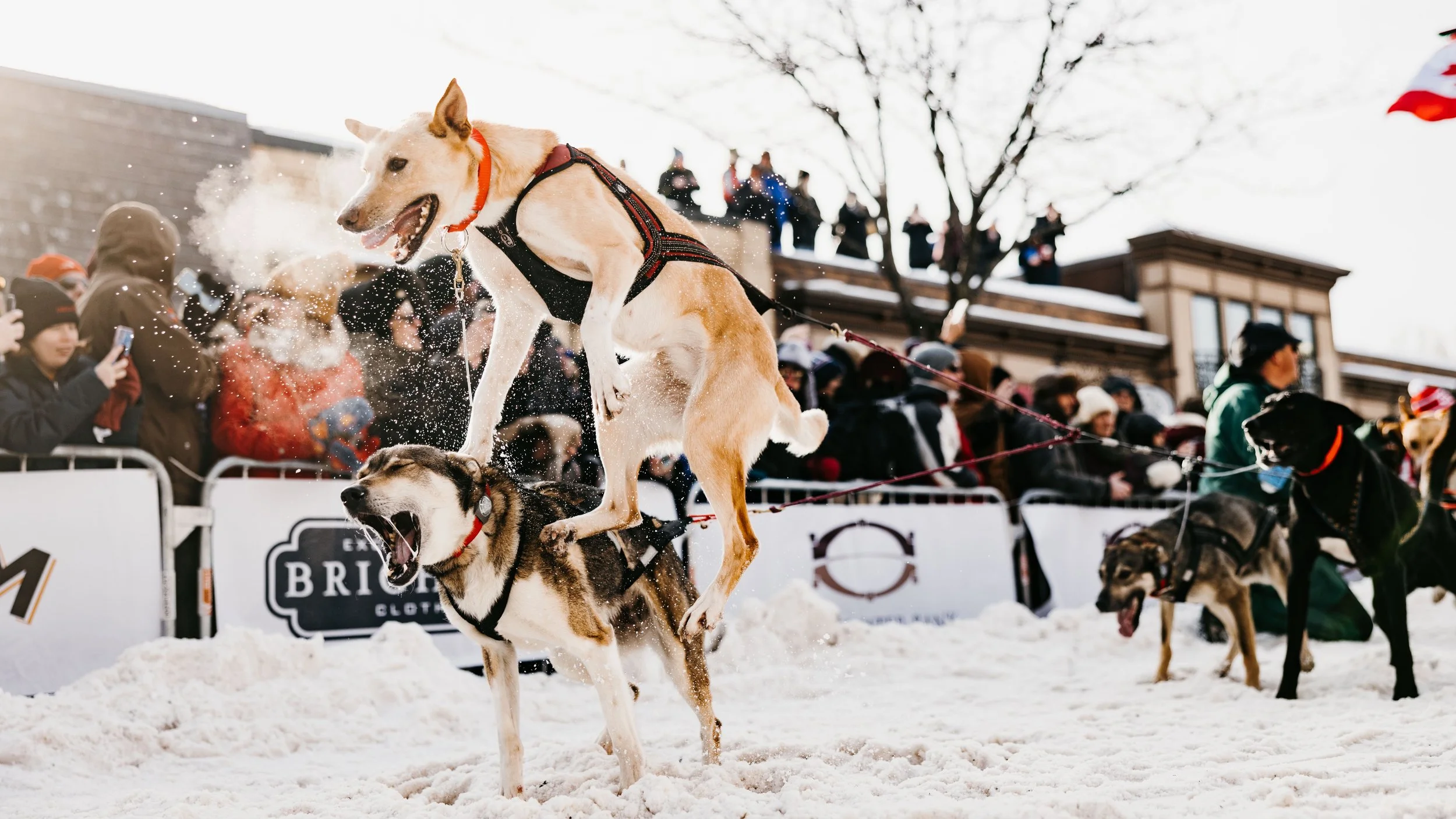
EDUCATIONAL VIDEOS ABOUT SLED DOGS
Mushing Explained: What do sled dogs eat?
Mushing Explained: Gearing up from the paws up
Mushing Explained: What Makes Dogs and Mushers Great Partners?
Mushing Explained: Genetic super-dogs
Mushing Explained: Designing the perfect dog sled
Sled Dogs: More Than Meets the Eye | National Geographic
Mushing Explained: Training for the Trail
Why Don't Sled Dogs Ever Get Tired?
COMMON MUSHING TERMINOLOGY
SOURCE: IDITAROD.COM
-
A type of sock that is made to protect the dog’s feet from small cuts and sores. These are made out of various materials, i.e., denim, polar fleece, trigger cloth, etc.
-
Commands for 180 degree turns in either direction
-
Tired or injured dog carried in the sled
-
Two dogs who lead the team side by side
-
A dog that the musher has dropped from his team at a checkpoint. The dog is cared for at the checkpoint until it is flown back to Anchorage to the musher’s handlers
-
Command for right turn
-
Command for left turn
-
Any northern type dog
-
Dog who runs in front of others. Generally must be both intelligent and fas
-
Command to lead dog to pull the team out straight from the sled. Used mostly while hooking dogs into team or unhooking them
-
Commands to start the team
-
Line that connects dog’s collar to tow line and between the two collars of a double lead
-
When the ice gets so thick that the water has nowhere to go, it pushes up and over the ice. This overflow often gets a thin layer of ice when the temperature drops making it dangerous to cross
-
Leading a team with some sort of motorized vehicle that can set the ‘pace’ at a specific speed
-
Pushing the sled with one foot while the other remains on the runner
-
A long chain with shorter pieces of chain extending from it. Used to stake out a team when stakes aren’t available
-
Collection of lines to which dogs are attached. Includes tow line, tug lines and neck lines
-
A musher who is running the race for the first time or who has never completed the race
-
The two bottom pieces of the sled which come in contact with the snow. They extend back of the basket for the driver to stand on. Runner bottoms are usually wood, covered with plastic or Teflon. This plastic or Teflon is usually replaced at least once during the race
-
Medium sized (average 50 pounds) northern breed of dog, recognized by the American Kennel Club. Siberians usually have blue eyes
-
Thin strips of wood which make up the bottom of a wooden sled basket. Note: Toboggan sleds have a sheet of plastic as the bottom for their basket
-
Heavy piece of metal attached to sled by line. The snow hook is embedded in the snow in order to hold the team and sled for a short period of time
-
Rope attached to the sled which is used to tie the sled to a tree or other object
-
Metal or wooden post driven into the ground to which dog is tied
-
Dog that runs directly behind the leader. Further identified as right or left swing depending on which side of the tow line he is positioned on. His job is to help “swing” the team in the turns or curves
-
Any dog other than those described above
-
Request for right-of-way on the trail
-
Line that connects dog’s harness to the tow line
-
Dogs placed directly in front of the sled. Their job is to pull the sled out and around corners or trees
-
Command used to halt the team, accompanied by heavy pressure on the brake
sled dog faqs
-
Alaskan Huskies are the most common dogs in the longest sled dog races, such as the Iditarod Sled Dog Race in Alaska and the John Beargrease Sled Dog Marathon in Northeast Minnesota. Siberian Huskies are 2nd most common. These dogs travel farther in their lifetime than any other land animal.
The types of dogs that’ll be at the Klondike Dog Derby are mostly Alaskan Huskies, some Siberian Husky teams, some Hound- and Pointer-crossed dogs that do better with shorter distances, and maybe some Samoyeds, Malamutes and possibly some even less common breeds.
Media tends to primarily show pure breed dogs like Malamutes, Canadian Eskimo dogs and Siberian Huskies as the definitive sled dog. Although it’s true that those are sled dog breeds, the majority of racing sled dogs are actually Alaskan Huskies, which is not a “pure breed.” Alaskan Huskies are generally smaller and have shorter fur than some of the other breeds—Siberian Huskies are similar in size, but they are fluffier, so they might just look bigger. The larger breeds, like Malamutes, are more of a freight-hauling dog; they pull a lot of weight and travel long distances, but they do it slowly and are less suited for racing.
-
Yes, they all have names. And we don’t just know their names—we know everything about them. We know their personalities, strengths and weaknesses, their life history, lineage and family relations. We know the sound of each of their barks and what they look like down to the small details. We know all of this because we spend a ridiculously large amount of time with them… and we love every minute.
-
Most racing kennels feed some combination of raw meat and high-performance dry dog food. Meat is a great ingredient, because it is so healthy and digestible. Mushers around here feed their dogs beef, beaver, chicken, fish, mink, venison and more.
-
No, or very rarely. The dogs know how to take care of themselves. People tend to compare them to their house pet at home, but that’s not fair to sled dogs. Sled dogs live truer to their ancestry and are perfectly content in their natural environment. Their feet stay warm when running; their blood is pumping and there’s no issue. When a dog gets up from resting and their blood isn’t circulating quickly yet, they might be more likely to raise a foot off of the snow to help the blood run through their feet. They can always curl up on the snow and raise their paws and tuck their nose in their tail to conserve heat—or they can go back in their house or dog box and curl up in the straw.
The booties they wear are primarily to prevent abrasion or other minor injuries from the wear and tear of running hundreds of miles. They are more for preventative maintenance and do very little to nothing to keep dogs’ paws warm.
-
Just wait until the start of the race… you won’t have to ask anymore! You’ll be able to see that they love it. The passion that sled dogs have for this lifestyle is so obvious, it’s contagious! That’s why mushers love it so much, too. It’s very rewarding to work with a team of dogs and to help develop and advance their skills. The dogs are so full of joy! They live a life that they can be proud of. Words cannot describe the bond that a musher has with his or her team. It’s truly a sight to see!
-
They live all over the world, but mostly in cooler climates. Some shorter-coat breeds live in somewhat warmer climates; they participate in events like canicross, bikejoring, or rig races because of the lack of snow or the time of year. Most of the teams at the Klondike Dog Derby are from Minnesota, Wisconsin, Michigan and Canada. Mushing is also huge in places like Northern Europe, Australia and Alaska.
-
Well, when a mommy and a daddy dog really love each other… actually, most kennels do a mix of breeding and raising their own pups. They’ll buy and bring in some older, experienced veterans to teach the younger ones. Mushers are less likely to buy or sell young pups, but it does happen occasionally.
-
For some reason, much of society tends to think that people who are lean and muscular are healthy, but that a dog needs at least an inch of fat on his ribs to be healthy. Sled dogs are extreme athletes. They cover more ground on foot in their lifetime than any other animal. They are the ultra-marathoners of the dog world. Many of them are so healthy, and their metabolism is so efficient, that they won’t get fat no matter how much you feed them. Not to mention, having excess weight on them would be unhealthy, unfair and potentially shorten their lifespan.
-
Sled dogs generally live longer than most breeds of similar sizes for several reasons:
1. Exercise. Their active lifestyle is a huge contributor to their long lifespan.
2. Diet. They don’t eat junk food.
3. Mental health. Sled dogs live a happy and stimulating life making them mentally happy and healthy.
4. Genetics. Sled dogs are genetically extremely healthy and often thrive into their mid-teens. They are not bred for looks. Even the working sled dog bloodlines of Siberian Huskies are bred for health. Alaskan Huskies are a very diverse breed—they are some of the healthiest dogs out there.
-
Lead dogs run at the very front of the team and most teams have several of them. Some teams might even be made up of nearly all lead dogs. This way, the musher can swap different leaders in or out depending on the conditions and the individual abilities of each dog. A lead dog is normally paired with another leader; new leaders are often paired with experienced leaders.
-
To put it simply, a musher is someone that drives a dog sled team.
The musher might not seem like a very important part of the team because they stand or sit on the sled… however, the musher is everything to the dogs. The musher is the coach, guide, navigator, troubleshooter, strategist, facilitator, chef, dietitian, hydration consultant, masseuse, medic, pedicurist, dentist, chauffeur, groomer, security guard, psychiatrist… and so much more. Most of a musher’s work is performed when the team is resting.
-
Mushers use voice commands. “Gee” (pronounced jee) is turn right. “Haw” is turn left. Those commands tell the dogs which path to take when approaching a split in the trail. Some lead dogs are more experienced and will lead by voice commands across large fields or lakes where there is no trail. The Klondike Dog Derby is a marked route on the ice.
There are other commands that are less universal. “Hike” means go; “whoa” means stop; “on by” means go past something. There are a variety of other words and variations that mushers use. Almost no one says “mush” anymore, but you may hear it from a musher or two.
-
Most mushers will tell you that they have never taught a dog to pull. Once mushers put a harness on them and hook them up, the dogs do the rest. They do what they love. It’s amazing to work with animals that don’t have to be taught—they just live their life the way they love to live it.
-
It’s their summer vacation. Like their ancestors long before them, they aren’t as active in the “dog days” of summer. They like to lay around and soak up the sun. They are very social animals; they love to run around and play with each other. They go for runs when it’s cooler—generally in the morning—but not for as many miles as they cover in the winter. Basically, they live a very similar lifestyle as their wolf heritage.
THANKS TO MUSHER, JAKE HWAY, FOR THE INFO AND FUN FACTS!
Interested in trying mushing? Set up a visit or tour with our partner sled dog tour operator, Chilly Dogs Sled Dog Trips.











